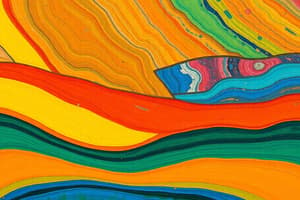Podcast
Questions and Answers
Describe what happens when two tectonic plates collide along a subduction zone.
Describe what happens when two tectonic plates collide along a subduction zone.
One plate becomes pushed underneath another.
Explain how subduction leads to volcanic activity.
Explain how subduction leads to volcanic activity.
One of the plates will be pushed down by great pressure and temperatures so deep that the water from the subducting slab will begin to accumulate between both plates, then eventually the plate will melt once the water lowers the temperature of the mantle. The magma then rises to the surface to produce a linear belt of volcanoes.
What is primary succession?
What is primary succession?
The development of plant and animal life in an area without topsoil; the development of biotic communities in a previously uninhabited and barren habitat with little or no soil.
Explain how primary succession can lead to soil formation on a newly formed volcanic landscape.
Explain how primary succession can lead to soil formation on a newly formed volcanic landscape.
Explain how a tsunami is generated along a subduction zone.
Explain how a tsunami is generated along a subduction zone.
Describe one negative ecological impact that tsunamis have on coastal environments.
Describe one negative ecological impact that tsunamis have on coastal environments.
Describe what happens to the tectonic plates along the transform boundary at the moment when an earthquake occurs.
Describe what happens to the tectonic plates along the transform boundary at the moment when an earthquake occurs.
Describe what happens to the tectonic plates along a transform boundary during the time between earthquakes.
Describe what happens to the tectonic plates along a transform boundary during the time between earthquakes.
Flashcards are hidden until you start studying
Study Notes
Subduction Zones and Tectonic Plates
- Tectonic plates collide at subduction zones resulting in one plate being pushed beneath another.
- Subduction creates conditions for volcanic activity due to high pressure and temperature triggering the melting of the subducted plate.
- The melting plate releases water, lowering mantle temperatures and forming magma that can rise to produce volcanoes.
Primary Succession and Soil Formation
- Primary succession occurs in barren environments lacking topsoil, leading to the establishment of biotic communities.
- On newly formed volcanic landscapes, primary succession can initiate soil formation from rock, aided by pioneer species that thrive in mineral-rich conditions.
Tsunamis and Their Formation
- Tsunamis are generated by the deformation of the ocean floor during tectonic plate subduction, resulting in underwater earthquakes.
- These earthquakes displace large volumes of water, leading to the formation of tsunamis, which can also be triggered by volcanic eruptions, landslides, or meteorite impacts.
Ecological Impacts of Tsunamis
- Tsunamis can cause significant ecological damage, including the destruction of crucial habitats such as mangrove forests and coral reefs due to flooding.
Transform Boundaries and Earthquakes
- During an earthquake at a transform boundary, significant energy is released due to the friction and stress accumulated between tectonic plates.
- Between earthquakes, tension and strain build up as plates remain locked together, culminating in a sudden release of energy when movement occurs.
Studying That Suits You
Use AI to generate personalized quizzes and flashcards to suit your learning preferences.




